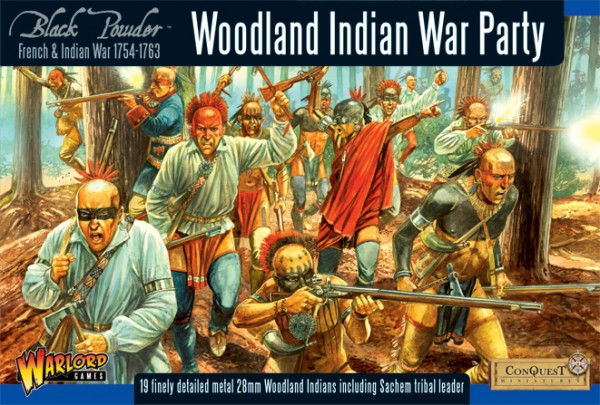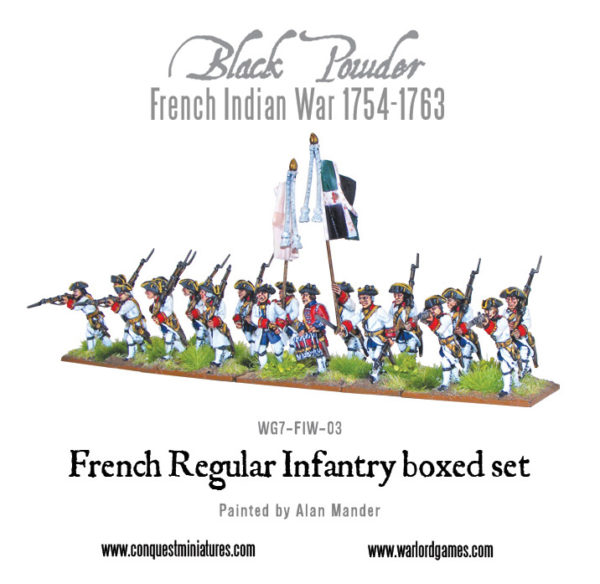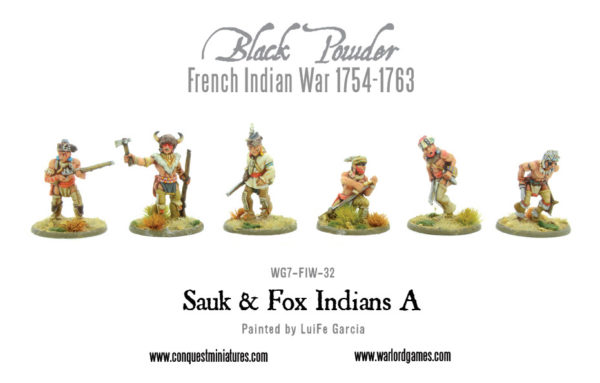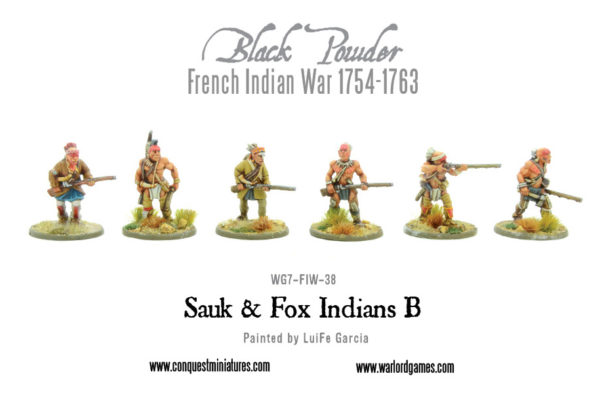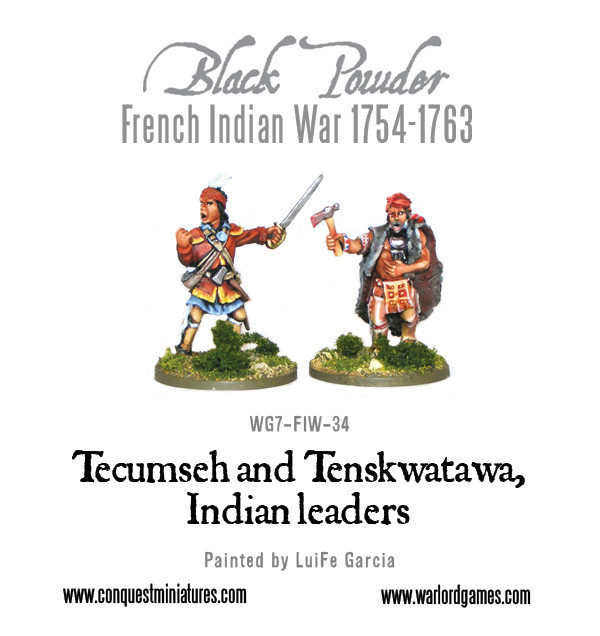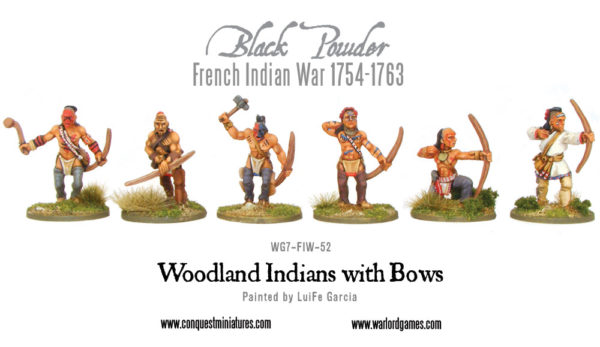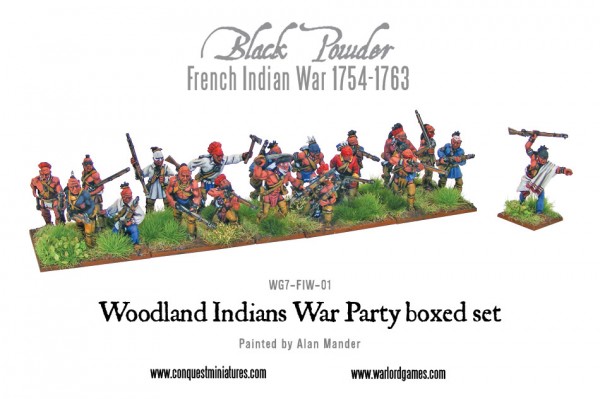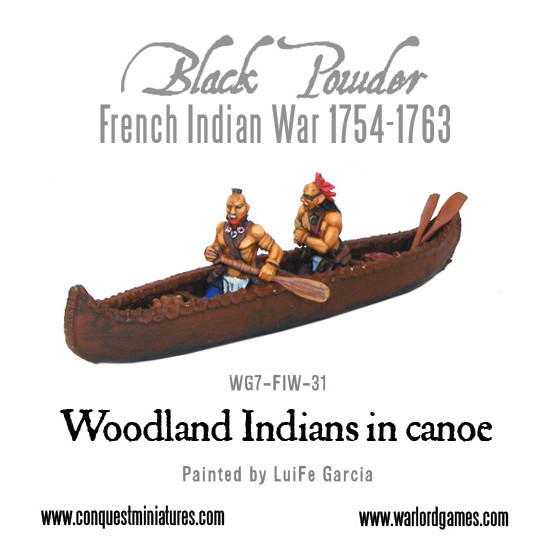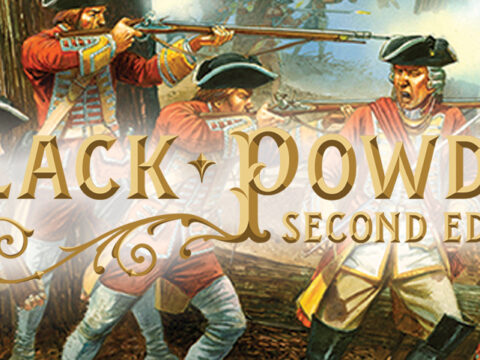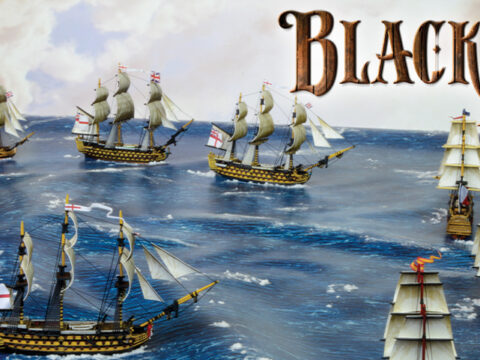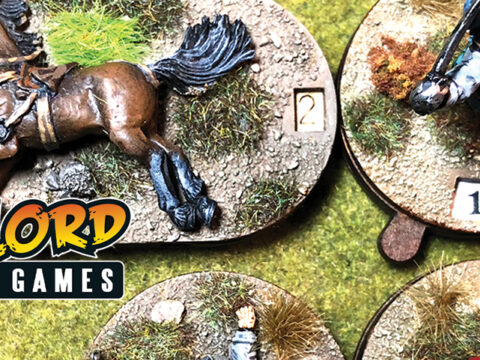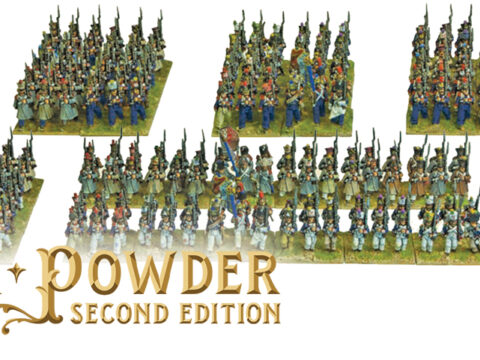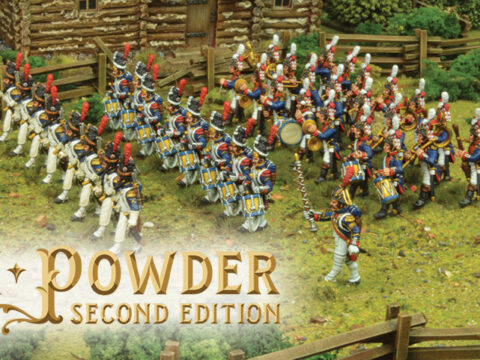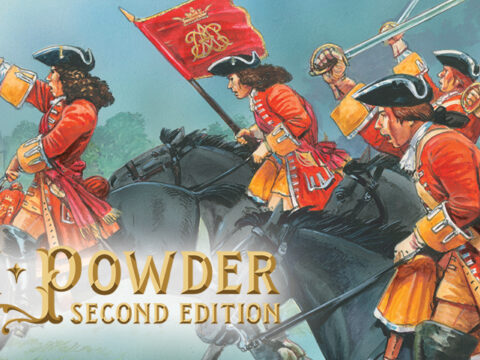Following his recent look at the Indian peoples inhabiting the Ohio Valley, Tim Greene examines the Woodland Indians whose territory is around the Great Lakes.
Part Two: The Great Lakes
By Tim Greene
This is the second in a series of three articles that looks at some of the important North American Woodland tribes and how the wargamer might customize his figures or paint his figures to most accurately represent them on the tabletop. The first article looked at the Ohio Valley tribes, this article examines the tribes of the Great Lakes region.
North of the Ohio Valley were the Great Lakes. The tribes living here were originally mostly speakers of various Algonquian languages except for the Siouan speaking Winnebagos. They did some farming but mainly lived by hunting and fishing. The land was rich and in the 1680’s and 1690’s there was a massive invasion of the area by tribes who had been broken by Iroquois attacks. These refugees were remnants of confederacies like the Huron, Erie, and Neutrals plus various Algonquin speaking bands. They forced their way into the Great Lakes region slaughtering and driving out the indigenous nations.
Eventually the French intervened. They rallied the Great Lakes tribes and mobilized them to make peace with the invaders and together turn on the Iroquois and their British allies. Eventually, with French assistance a measure of stability returned to the Great Lakes region which remained a bastion of anti-British sentiment through Pontiac’s rebellion in the 1760’s.
Chippewa
The Chippewa were an Algonquian speaking tribe of hunter-gatherers who lived around Hudson’s Bay and extended down to the Great Lakes. They were numerous, consisting of many loosely organized bands. Their closest relatives were the Ottawa and the Potawatomi and all these tribes were known as the Three Fires Confederacy. They were among the staunchest allies of the French frequently fighting the British and other tribes on their behalf.
When the Miamis defected from the French alliance to gain access to British trade goods it was the Nippissings (a band of these people) who helped the French destroy the Miami town of Pickawillany. War parties frequently went south against the Catawba after those people killed many French trappers. The Chippewa were formidable warriors who more than held their own against the Iroquois and were a major factor in stopping the Five Nation’s invasion of the Great Lake’s region.
Chippewa men wore breechclouts with long flaps in front and back. Sometimes a kiltlike garment fringed at the bottom was worn instead. Leggings were close-fitting and worn to above the knees and gartered below the knees or else thigh length and tied with thongs or straps to a belt. Buckskin ponchos were worn in cool weather. Chippewa men wore their hair loose, occasionally braided with scalplock at the back. Warriors liked to stiffen the scalplock so it stood up straight for several inches.
Moccasins were well fitted with a puckered seam running up the front and a plain seam at the back. Later moccasins had vamps with the skin puckered into the vamp and a seam from toe to vamp. Cuffs on both ankles were worn, men liked to attach a foxtail behind on the heels. Vamps and cuffs decorated with quillwork or moose-hair embroidery in floral patterns. The Chippewa sometimes painted green spots in an arc across the face. Red, black, green and yellow paint was used for war.
Fox
The Fox were an Algonquian speaking people who may have originally come from the Michigan Peninsula. They were part of the Fire Nation, a confederacy also containing the Sac, Kickapoo, and Mascouten who were driven into Wisconsin during the invasions of the Great Lakes region by the refugees fleeing from the Iroquois. The Fox were especially formidable fighters. In the 18th Century they unwisely chose to single-handedly oppose the French while simultaneously alienating most of their neighbors. This resulted in the near destruction of the Fox Nation. The remnants were taken in by the Sacs and became the Sauk & Fox Nation.
Fox men wore breechclout and moccasins in summer with thigh length leggings and a shirt added in winter. Leggings were fairly fitted with fringes at the sides and large pointed flaps at the bottom which covered most of the foot. The leggings were seamed up front and had garters sometimes of fur. Geometric quillwork and later floral and traditional moosehair embroidery decorated garments which were lavishly covered, more so than among the Sauk.
Garments could also be painted in bright hues in solids and stripes or figures and designs like the Miami. Among the Fox the roach was almost universal. Men shaved the head with a tuft running from front to back left on and a scalplock left hanging from the crown. The tuft was sometimes shaved leaving the scalplock and roach and the top part of the shaved skull was painted red. Some Fox wore a turban of otter fur. A few sported buffalo horn headdresses captured from enemies like the Sioux and Iowa. Some Fox wore a tuft from side to side rather than front to back on the shaved head. One segment of the tribe wore their hair long and loose.
Fox moccasins were soft soled one piece with a seam up the front from toe to instep covered by quillwork. Flaps or cuffs of men’s moccasins were of exaggerated size and heavily decorated with quillwork or embroidery in geometric patterns, each flap with a different design then reversed on the other moccasin as for the Sauk, Miami, and Potawatomi. Fox warriors used red and black pigments. Some Fox chiefs painted by a European artist had their faces painted blue. Yellow, red, and black stripes could be painted on the lower half of the face. Hands painted on the body meant an enemy killed in hand to hand combat.
Ojibwa
Most of the remarks under the Chippewa also apply to the Ojibwa. The western bands generally went under the name Ojibwa rather than Chippewa.
Ojibwa men wore very little, a fitted breechclout with flaps hanging in front and back and moccasins with a robe added in winter. Buckskin shirts embroidered and painted with attached scalplocks (like those of the Plains tribes) could be worn. Leggings were thigh or above the knee length were gartered at the knees, fringed on the sides, and decorated with porcupine quillwork and moosehair embroidery. Skin garments were frequently dyed black and edged with short fringes. Some men wore the hair long, hanging naturally. Others wore two or four braids. Warriors, in particular, shaved the head except for a brush or roach on top and a scalplock hanging behind. Other warriors coiled their braids atop the head wrapped in bark to make them stand erect. Hair could be painted with red or yellow paint.
Ojibwas wore one piece tanned deerskin or moosehide often dyed black with a seam up the front from toe to instep or had the skin puckered into a U or oval shaped vamp. A variation had a straight seam across the toe into which the skin was puckered resembling a partridge’s fantail; the seam up the instep and on the heel were fringed. The face and body were painted using red ocher and black charcoal or soot in dots, bars, patches and other simple designs. Men were extensively tattooed, the bodies often covered with designs.
Ottawa
The Ottawa were too far north for agriculture and their land was poor in the wild rice so abundant in the land of the Dakota and Chippewa. There also were few fur bearing animals in Ottawa country. So the Ottawa became great traders. This honed their diplomatic skill and they eventually produced one of the greatest Native American leaders, Pontiac. The Ottawa had a reputation for cunning, treachery, and cruelty. They were adequate warriors. Very loyal to the French they were the nucleus of anti-British hostility after the French and Indian War.
The French often remarked on the prevalence of nudity among the Ottawas. Men usually wore only a robe and moccasins. Sometimes a fitted leather breechclout was worn with flaps in front and back, decorated with quillwork. Leggings, when worn, were thigh length simple tubes of hide, fringed on the outside seams and gartered just below the knees. Among the Ottawa the roach was worn by some men. The head was often shaved except for a central tuft standing high from front to back decreasing in height towards the back and a scalplock hanging from the crown. The hair could be worn in two or four braids sometimes wrapped in fur or thongs. Others allowed the hair to hang loose or shaved it all except for a tuft at the crown.
Ottawa moccasins were deerskin and sometimes moosehide one piece soft soled with seam from toe to instep and the sole puckered into it. The seam was often covered with a strip of quillwork. Cuffs were usually attached and could be worn down or up around the ankle fastened with thongs. The sole was later puckered into a U or oval shaped vamp as among the Ojibwa.
Ottawa men were commonly tattooed. Designs included lizards, snakes, and geometrical figures, sometimes covering the entire body. The face and body were painted with red, brown, green, and black.
Potawatomi
The Potawatomi were close relatives of the Ojibwa, Chippewa, and Ottawa. They were good warriors and staunch allies of the French.
Potawatomi men wore tanned leather breechclout with quillwork bands at the bottom, flaps hanging down to the knees in front and in back. Leggings were deerskin, thigh length fringed down the side seams and gartered below the knees; some were decorated with strips of quillwork at the sides. Unseamed pieces of tanned skin were worn for shirts. The Potawatomi decorated their garments with quillwork in geometric designs and with dyed moosehair in modified floral designs. Potawatomi men wore their hair long but warriors shaved their heads and wore the roach.
The most common style was a tuft of hair from front to back with a scalplock hanging down. A single eagle feather was often added at the back. Potawatomi moccasins were soft soled and one piece with a seam up the front from toe to instep covered by a decorated band of quillwork. Cuffs were very large and pointed in front extending almost to the ground and with the designs symmetrically opposed for each cuff, like those of the Miami. Warriors painted their faces red and black, especially the upper face which might be all black. Black and red were painted around the eyes, maybe black around one eye and red around the other or both ringed either red or black.
Sauk
Closely related to the Fox and Kickapoo the Sauk were staunch French allies. They moved south into the territory of the Illinois Confederacy in the 18th Century occupying the area around the Rock River and the Mississippi River. The Sauk eventually absorbed the remnants of the Fox tribe after that tribe was nearly destroyed by the French. The combined tribes were thereafter known as the Sauk & Fox.
Sauk men wore breechclout and moccasins in summer with a robe added in winter. The breechclouts, usually painted red, were of the fitted type without flaps. Hip length leggings of deer or elk skin were worn. These were made white with clay and decorated with porcupine quillwork and fringes at the sides. Others, unfringed, were snug fitting with flaps at the bottom which covered most of the foot. Geometric quillwork and abstract floral moosehair embroidery decorated garments. Among the Sauk the roach was almost universal. Men shaved the head with a tuft running from front to back left on and a scalplock left hanging from the crown. The tuft was sometimes shaved leaving the scalplock and roach and the top part of the shaved skull was painted red. Some Sauk wore a turban of otter fur.
A few sported buffalo horn headdresses captured from enemies like the Sioux and Iowa. Sauk moccasins were soft soled one piece with a seam up the front from toe to instep covered by quillwork. Flaps or cuffs of men’s moccasins were of exaggerated size and heavily decorated with quillwork or embroidery in geometric patterns, each flap with a different design then reversed on the other moccasin as for the Miami and Potawatomi. In painting the face and body white and black pigments were favored. White stripes were sometimes painted round the arms and legs. The eyes were often rimmed in red paint. Hands painted on the body meant an enemy killed in hand to hand combat.
Winnebago
The Winnebago were a Siouan speaking tribe who lived in what is today Wisconsin. They are considered the parent tribe by other Siouans and their name for themselves translates as “people of the parent speech”. Early traditions connect the Winnebago with the northernmost Mound Builder center of Azatalan. They had a reputation for being haughty and arrogant, looking down on the surrounding tribes as inferior. They also had a reputation for treachery and cannibalism. The Winnebago sent warriors to help the French occasionally but mostly they stayed neutral and did not play as large a part in the imperial wars on the North American continent as many of the other tribes in the region.
Winnebago men wore breechclouts of three pieces consisting of an underpiece and two apron flaps or a long, one piece one ending in flaps. These were of elk or deerskin and painted red or black. Winnebago leggings were seamed down the front and close fitting. They came down over the foot in a point or else were cut square across the instep. They were often knee length and gartered below the knees made of elk or deer hide also. In cooler weather a poncho type shirt reaching the hips was worn. Shirts and leggings had the short fringes typical of the Winnebagos.
Winnebago moccasins were one piece and soft soled. The men’s were seamed down the front and had a strip of porcupine quillwork or later beadwork covering the seam. The flaps on either side were rounded and decorated the same way. Winnebago men wore their hair in two braids or just clumped on either side and fastened with thongs. A few men wore the roach for war, usually with a roach spreader and one or two feathers inserted in a swiveling socket. Headdresses made of rawhide with buffalo horns and grizzly-bear claws were worn. Warriors painted the face and body with red and black or green. A hand painted on the face or breast signified killing an enemy. Warriors who had gone on the warpath in winter painted the legs white.
By the early nineteenth century all the tribes were wearing a lot of cloth manufactured in England or America, especially calicoes and red or blue strouding. Sashes were often woven around the head like a turban. The third article will look at the tribes of the Southeast.

